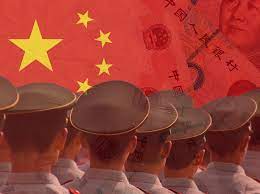Authors: Andrew Scobell, Edmund J. Burke, Cortez A. Cooper III, Sale Lilly, Chad J. R. Ohlandt, Eric Warner, and J.D. Williams
Affiliation: RAND Corporation
Organization/Publisher: RAND Corporation
Date/Place: 2020/ USA
Type of Literature: Research Report
Number of Pages: 154
Link:https://www.rand.org/content/dam/rand/pubs/research_reports/RR2700/RR2798/RAND_RR2798.pdf
Keywords: The Chinese strength components, China in 2050, Grand Strategy, and the Future of China-US Rivalry
Brief:
This lengthy report, sponsored by and for the benefit of the US Army, attempts to predict the nature of Sino-US relations during the next thirty years, by studying China’s Grand strategy, its goals, pillars, and the implementation mechanisms, then assessing the extent to which China can implement this strategy and achieve its major goals by 2050. The report consists of six chapters including an introductory chapter that identifies the research methodological tools, and a chapter that tracks the historical development of China’s grand strategy between 1949-2017. China’s strategy is mainly to become a regional and then global power, with an effective governance model, achieve social stability, economic prosperity, and achieve comprehensive advances in sciences, technology and military power by 2050. The report points out that China’s ambitious strategy during the next three decades has been announced explicitly, but China’s leadership will focus more on local and vital regional issues, especially the South China Sea, in an attempt to build a regional order subject to its benign leadership. The third chapter highlights China’s leadership and political system, the mechanisms and goals of Chinese governance, as well as the interaction of this leadership with society and its political culture. The chapter also identifies internal problems and how they affect national defense issues, arguing that Chinese leadership’s mentality of decisive control over society in order to maintain internal stability is an essential factor to ensure the success of China’s grand strategy. The fourth chapter analyzes the main areas that underlie China’s grand strategy, namely diplomacy, economy, and technology, explaining the reforms that China is integrating in these vital areas in order to mobilize and achieve the major strategic goals. Here, the report pays tribute to China’s success in weaving successful and wide-ranging diplomatic relations across its region and the world, and achieving unprecedented economic openness; and the report applauds its ability to conquer global markets with its technologies and impose itself as a leading power at the regional level. However, the report identifies some obstacles hindering China leadership’s efforts, such as the contradiction between the nature of China’s political regime (based on internal political control) and the features of openness and external tolerance that China is keen to show to neighbors and the world. The fifth chapter details China’s military strategy, and the reforms made to the Chinese People’s Liberation Army in order for it to adapt to new changes consistent with China’s grand strategic goals and mechanisms. The report confirms that China is keen to obtain the capabilities of “comprehensive national power,” and avoiding any confrontation with the US military in the Pacific through the rational management of competitive relations and resolving threats arising from this competition in a way that doesn’t threaten strategic goals or portray a negative (threatening) image among neighbors. This will be a difficult challenge for China. The last chapter attempts to anticipate what will become of China thirty years from now, and how the future form of China will affect the nature of Sino-American relations. The report outlines four possible scenarios for China: triumphant China, ascendant China, stagnant China, or imploding China. The report excludes the first scenario because it allows little margin of error and assumes a period free of any major crisis in which no serious competitor faces China—all of which are unrealistic assumptions. It also excludes the fourth scenario, given the Chinese leadership’s skill in organizing, planning and being able to cope with crises successfully. Therefore, the most likely scenario fluctuates between China’s continued rise and achieving a good extent of successes on the one hand, or China’s facing major challenges that stop the pace of this rise and make it fail to implement its grand strategy on the other hand. Accordingly, the report sets out three possible scenarios for the nature of Sino-US relations that will inevitably be the result of China’s future form, namely: parallel partners, colliding competitors, or diverging directions. The first scenario will be the result of ascendant China or stagnant China. The second scenario will be the result of triumphant China, while the third scenario will be likely if China is subject to collapse and turns away to solve its internal crises. Based on the most likely scenarios (ascendant China or stagnant China), the report provides a set of practical recommendations for decision-makers in Washington, DC to deal with the problematic situation. Recommendations include improving the performance and capabilities of the US military in dealing rapidly with emergency crises and coordination with East Asian allies, avoid confrontation and engage in disputes with China and keep the competition situation low, while ensuring the technological, maritime and air superiority over China to make the leadership in Beijing think more than twice before deciding to enter into confrontation with the US military which is there to expel it from the region permanently.
By: Djallel Khechib, CIGA Senior Research Associate




